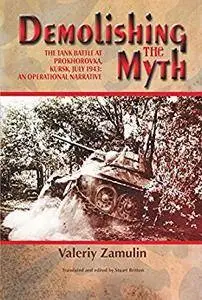Demolishing the Myth: The Tank Battle at Prokhorovka, Kursk, July 1943: An Operational Narrative by Valeriy Zamulin
English | 27 Jun. 2011 | ISBN: 1906033897, 1912174359 | ASIN: B0759GSLN3 | 664 Pages | AZW3 | 18.85 MB
English | 27 Jun. 2011 | ISBN: 1906033897, 1912174359 | ASIN: B0759GSLN3 | 664 Pages | AZW3 | 18.85 MB
on 12 July. The combat on this day receives particular scrutiny, as Zamulin works to clarify the relative size of the contending forces, the actual area of this battle, and the costs suffered by both sides. The costs to General P. A. Rotmistrov's 5th Guards Tank Army and General A. S. Zhadov's 5th Guards Army as they slammed into 1st SS Panzer Grenadier Division Leibstandarte Adolf Hitler, 3rd SS Panzer Grenadier Division Totenkopf and a portion of 2nd SS Panzer Grenadier Division Das Reich were particularly devastating, and Zamulin examinesA groundbreaking book when first published in Russia in 2005, now Valeriy Zamulin's study of the crucible of combat during the titanic clash at Kursk - the fighting at Prokhorovka - is available in English. A former staff member of the Prokhorovka Battlefield State Museum, Zamulin has dedicated years of his life to the study of the battle of Kursk, and especially the fighting on its southern flank involving the famous attack of the II SS Panzer Corps into the teeth of deeply-echeloned Red Army defenses. A product of five years of intense research into the once-secret Central Archives of the Russian Ministry of Defense, Zamulin lays out in enormous detail the plans and tactics of both sides, culminating in the famous and controversial clash at Prokhorovka on 12 July 1943. Zamulin skillfully weaves reminiscences of Red Army and Wehrmacht soldiers and officers into the narrative of the fighting, using in part files belonging to the Prokhorovka Battlefield State Museum. Zamulin has the advantage of living in Prokhorovka, so he has walked the ground of the battlefield many times and has an intimate knowledge of the terrain.
Examining the battle from primarily the Soviet side, Zamulin reveals the real costs and real achievements of the Red Army at Kursk, and especially Prokhorovka. He examines mistaken deployments and faulty decisions that hampered the Voronezh Front's efforts to contain the Fourth Panzer Army's assault, and the valiant, self-sacrificial fighting of the Red Army's soldiers and junior officers as they sought to slow the German advance, and then crush the II SS Panzer Corps with a heavy counterattack at Prokhorovka the nuts and bolts of the counteroffensive to see why this was so.
Zamulin does not exclude the oft-overlooked efforts of Army Group Kempf's III Panzer Corps on the right-wing of the Fourth Panzer Army, as it sought to keep pace with the II SS Panzer Corps advance, and then breach the line of the Northern Donets River in order to link up with its left-hand neighbor in the region of Prokhorovka. Zamulin describes how the Soviet High Command and the Voronezh Front had to cobble together quickly a defense of this line with already battered units, but needed to reinforce it with fresh formations at the expense of the counterstroke at Prokhorovka.
Illustrated with numerous maps and photographs (including present-day views of the battlefield), and supplemented with extensive tables of data, Zamulin's book is an outstanding contribution to the growing literature on the battle of Kursk, and further demolishes many of the myths and legends that grew up around this battle.



